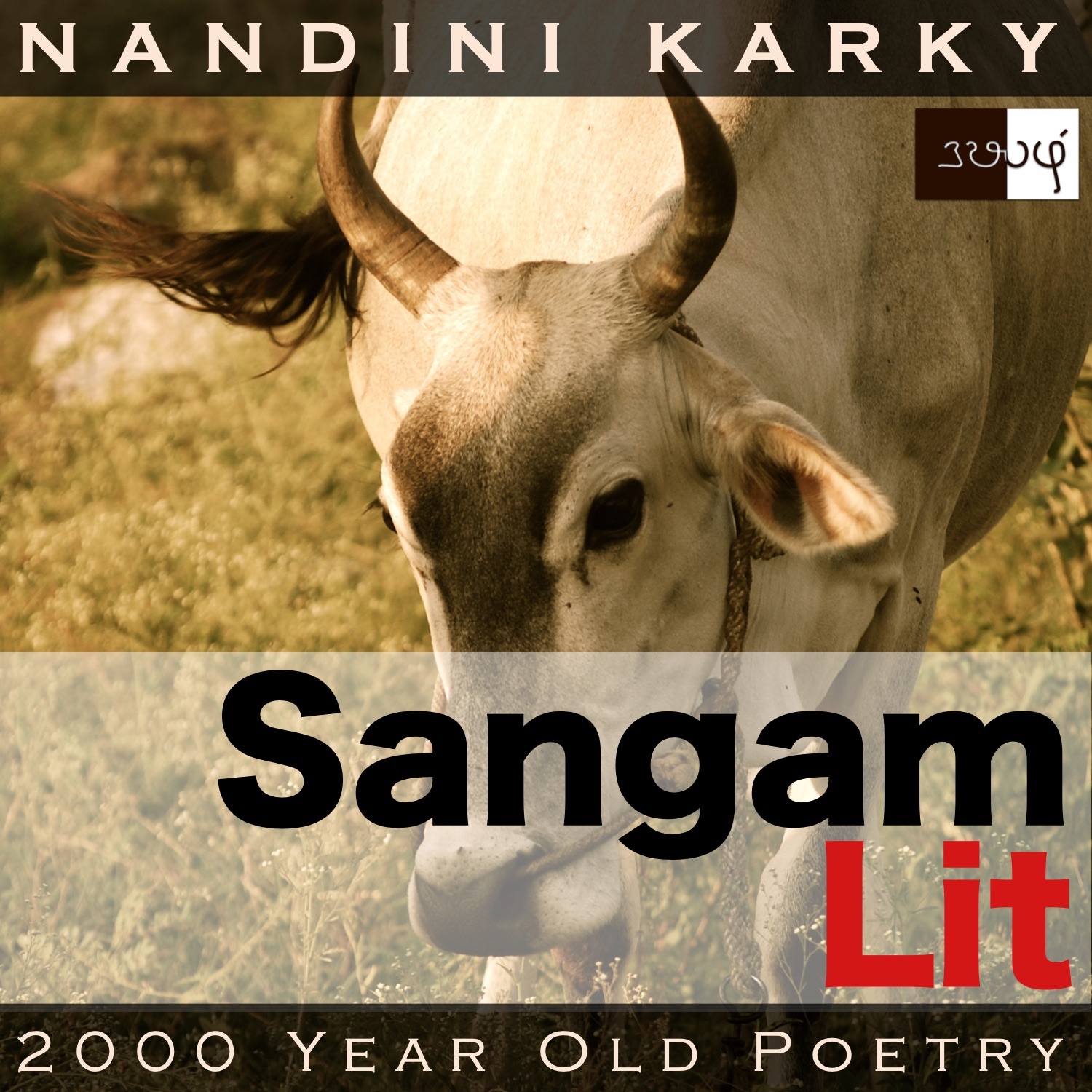Podcast: Play in new window | Download
Subscribe: Apple Podcasts | Spotify | Amazon Music | Android | iHeartRadio | TuneIn | RSS | More

In this episode, we perceive deep facets of inner life, depicted in Sangam Literary work, Natrinai 109, written by Meeli Perumpathumanaar, this being his only Sangam poem. The verse is set in the ‘Paalai’ landscape and revolves around the theme of separation. Speaking in the voice of the lady to her confidante, the poem expresses the anguish in the lady’s heart, as the man has not returned from his journey.
”ஒன்றுதும்” என்ற தொன்று படு நட்பின்
காதலர் அகன்றென, கலங்கிப் பேதுற்று,
”அன்னவோ, இந் நன்னுதல் நிலை?” என,
வினவல் ஆனாப் புனையிழை! கேள், இனி
உரைக்கல் ஆகா எவ்வம்; இம்மென
இரைக்கும் வாடை இருள் கூர் பொழுதில்,
துளியுடைத் தொழுவின் துணிதல் அற்றத்து,
உச்சிக் கட்டிய கூழை ஆவின்
நிலை என, ஒருவேன் ஆகி
உலமர, கழியும், இப் பகல் மடி பொழுதே!
The poem begins with the word that epitomises a love relationship, ‘ஒன்றுதும்’ meaning ‘we are one’! The relationship itself is described by the words ‘தொன்று படு நட்பு’, meaning ‘an ancient friendship’. A phrase to pique one’s curiosity! What could the lady mean by this phrase? Let’s delve into that shortly. The lady is characterised by the words ‘நன்னுதல்’ meaning ‘a beautiful forehead’. The word ‘எவ்வம்’ meaning ‘misery’ reminds me of a Tamil lyric in a sci-fi movie that goes, ‘எவ்வத்தின் நுதிகாண நீயாற்று மேதும் எவ்வாறு இங்கே பிழை?’ meaning ‘What could be wrong about anything done to end the root of suffering?’ Echoes of Tamil from the depths of the mind to the expanse of the universe, across the centuries. Instead of simply calling the night as ‘night’, the phrase ‘பகல் மடி பொழுது’ characterises it as the ‘killer of the day’ and perhaps, the lady words it so, as it drives a knife through her heart too. Let’s listen on, to understand why.
The man and woman have been in a love relationship and the man has parted away to gather wealth, perhaps towards their marriage. The time he said he would return has passed. As the confidante tries to console the grief-stricken lady, the lady tells her, “O bejewelled friend, you ask me, “What would be the state of this lady with a fine forehead, who is confused and agonised by the separation of that lover, who promised her the ancient relationship that proclaims they two were one?” Listen to my unspeakable sorrow! It’s the time when northerly winds roar amidst the darkness of the night. In the muddy cowshed where raindrops fall, a short-statured cow, that should be removed elsewhere, has been tied to the roof, for want of a pillar. My state is that of the struggling cow, unable to rest or roam, as I spend this night, full of distress, on my own!” With these words, the lady paints a nuanced picture of the state of her mind, as the man remains away from her.
Now, let’s unravel the fine elements of this verse. First, that ancient relationship! Is it an ancient relationship because the lady and man have been together, a long time? Or is it one that extends across many births, like some explanations I read, described? Or is it something else entirely? We should first see that this ancient relationship talked about here is a love relationship where two people are united and although they may have two different bodies, they feel they are of one mind and heart! Any interpretation has a subjective dimension and so to me, this phrase appears as one characterising a relationship that has existed since the beginning of human emotions. The meaning of this verse, that two people in love are one is something that seems true, no matter where or when in human experience. Thus, the words ‘ancient relationship’ in this verse seems to portray an understanding that the feeling of ‘oneness in love’ has existed from far beyond known human history.
Another fascinating fact is the way Sangam poets seem to characterise someone as the epitome of their physical characteristics, for instance, the lady is a ‘fine forehead’ and the confidante is the ‘wearer of ornate jewels’. There are no names in Sangam Akam poetry. Perhaps, it’s written in that style so that any one can relate to it and become the characters portrayed. So, such quaint expressions for the characters seem to be an ingenious way of naming them without naming them!
The core of this verse sits in a single simile. The lady brings before our eyes, a dwarfish cow in a slush-filled cowshed. Looking carefully, we see that the cow has been tied to the roof instead of a pillar. Raindrops are falling in. A cold northerly wind blows through the shed too. But, there’s no one to come around and help that cow, which cannot settle down to take a bit of rest, nor can it move around freely. Such is her sorrowful state too, in that melancholic evening, says the lady. At first she talks of the pain in her heart as an ‘unspeakable sorrow’ but in the end, she finds the words. Perhaps, that’s all it takes. When the heart is burdened, we need not demand instant solutions but rather, just the words to express the pain as it is. The poem seems to whisper to me, ‘verbalise and watch your angst gently vaporise’!




பாலை நிலம், பாழடைந்த மாட்டுக்கொட்டகை,. சகதியான தரையில் மாடு வெகு நேரம் படுத்திருந்தால் அதன் நலத்துக்கு கேடு என்பதால் அதன் தலைக்கயிற்றை கூரையைத் தாங்கும் தூணில் எப்போதும் போல் இன்றி உச்சியில் கட்டுவது வழக்கம்.